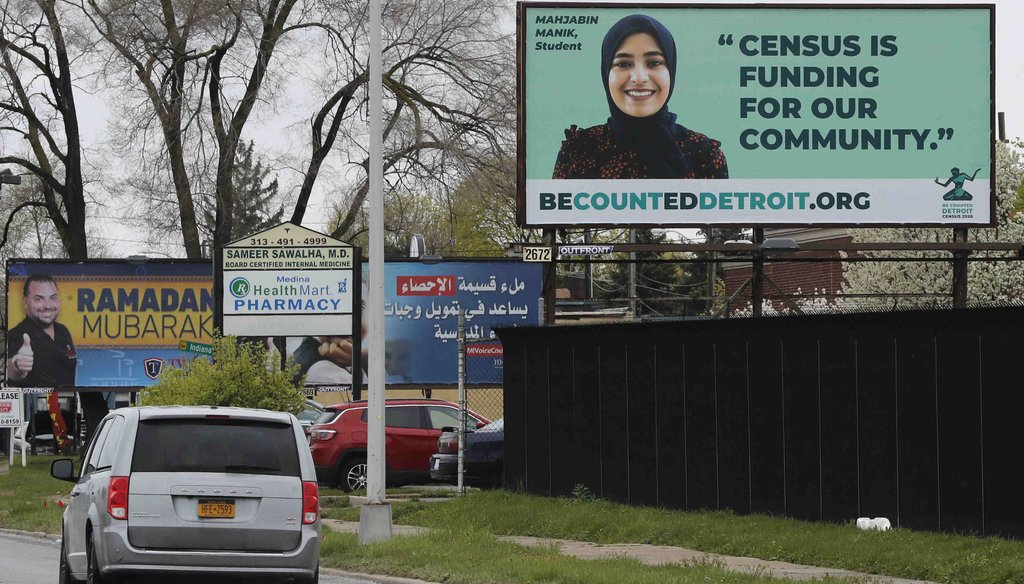Stand up for the facts!
Our only agenda is to publish the truth so you can be an informed participant in democracy.
We need your help.
I would like to contribute

A billboard urges Detroit's Arab American community to complete the 2020 census (AP Photo/Carlos Osorio)
If Your Time is short
-
The U.S. Department of Health and Human Services uses population counts from the census to determine how it allocates funding to states for Medicaid.
-
An undercount could reduce the federal contributions to a state’s Medicaid program.
-
While Michigan has one of the highest rates of residents who have completed the census online, by phone or by mail, it has been hit hard by the public health and economic crises created by the coronavirus, and its Medicaid rolls are expected to grow.
With the crucial 2020 census running in the midst of a pandemic, many officials worry that undercounted communities will lose out on billions of federal health care dollars allocated to states and localities based on census data.
Rep. Andy Levin, who represents Michigan’s 9th congressional district, took to Twitter to try to explain what’s at stake. "Every person who completes the #2020census brings nearly $1,000 for health care to their community. That means if 5% of Americans don’t get counted, we’ll lose $16.5 billion for local health care services," he wrote.
After PolitiFact Michigan reached out to Rep. Levin’s office, the tweet was deleted and replaced with a new one focusing on Michigan.
"Every Michigander who completes the #2020census brings nearly $1,000 for health care to their community. That means if 5% of Michiganders don’t get counted, we’ll lose nearly $500 million for local health care services," the revised tweet reads.
The correction illustrates the need to better understand how census data influences the distribution of federal funds to states and localities, particularly for health care amid the coronavirus crisis, which hit Michigan hard.
The federal government makes substantial contributions to Michigan’s Medicaid program, which provided health insurance for nearly one million residents in the last fiscal year. That number is expected to rise this year since economic downturns tend to result in higher Medicaid enrollment. Early analysis shows that the coronavirus has led to rising Medicaid enrollment across the U.S., likely due to the rise in unemployment and the loss of employer-provided insurance.
What did the deleted tweet get wrong?
The first tweet stated that each American who is not counted by the census creates a $1,000 loss in federal funding for health care programs. But how much federal health care funding is attributable to each respondent depends on which state they live in. So the impact of a census undercount varies by state.
The deleted tweet also claimed that a national undercount would lead to a significant loss of federal funding for health care services. That’s not quite right. An undercount doesn’t eliminate the federal funding. It just means that it is allocated differently between places.
The funding for most federal programs that rely on census data is determined by appropriations passed by Congress. Congress agrees on how much money should be made available, and then census data help agencies determine how that money is allocated to states and localities.
"Funds lost in one state or area due to an undercount are not returned to the U.S. Treasury. They are distributed to all other states and areas," writes Andrew Reamer, a research professor at George Washington University.
How is federal health care funding allocated to the states?
Reamer looked at how an undercount would affect funding for several HHS grant programs that rely on census-derived data. These programs fund Medicaid, Medicare’s prescription drug coverage, the Children’s Health Insurance Program, foster care agencies, adoption assistance and the Child Care and Development Block Grant in each state.
Federal funding allocations to states for these programs are determined by a metric called the Federal Medical Assistance Percentage, which is calculated annually based on decennial census data and other factors.
A state’s FMAP indicates how much it will be reimbursed by the federal government for each dollar it spends. The higher the FMAP, the greater the federal reimbursement to the state. For instance, Michigan’s FMAP for the 2021 fiscal year is 64.08%, meaning the federal government contributes about 64% of the costs associated with these programs.
By statute, FMAPs can range from 50% to 83%. States with lower per capita incomes have a higher FMAP. Because a state’s per capita income is calculated by dividing its total income by its population, an undercount of the population could yield a higher per capita income, and a lower FMAP. The federal government would likely contribute less health care funding to the state as a result of the undercount.
But "with FMAP-funded programs, it's hard to know how a lower FMAP would translate," Reamer acknowledged. The federal funding is structured as a reimbursement, so the state must first spend the money before federal contributions kick in.
Because most states have to balance their budgets, a reduction in federal reimbursements for FMAP-funded programs leaves state governments with few options: "reduce Medicaid-funded services, reduce other health services, reduce non-health services like education or increase taxes to make up the difference," Reamer said.
How would an undercount in Michigan affect funding for health care programs?
Reamer’s analysis looked at the 2015 fiscal year and found that for every Michigander not counted in the 2010 census, the state missed out on $954 in federal funding for the HHS programs that use the FMAP. He also estimated that for every 1% that the population was undercounted in 2010, Michigan lost nearly $94.3 million in federal funding to support these programs.
These estimates are the basis for Rep. Levin’s claims that each Michigander not counted leads to a loss of nearly $1,000 in health care funding for the state and that an undercount of 5% would entail a loss of nearly $500 million.
This fiscal loss would have the greatest impact on Medicaid, which accounted for about 90.8% of the total federal funding for HHS programs in fiscal year 2015.
How has Michigan’s response rate been?
Michigan has one of the highest self-response rates to the 2020 census: 69.6% of Michiganders have responded to the census online, by phone or by mail, compared with 64.5% nationwide.
But self-response rates within the state vary. Detroit’s rate is under 50%, trailing rates in other American cities. Northern Michigan and the Upper Peninsula have also seen low self-response rates.
There is not much time left to fill the gaps and ensure every Michigander is counted. After the Trump administration initially extended the deadline to complete the census count to October amid the COVID-19 pandemic, the deadline was subsequently changed back to Sept. 30.
Our Sources
Jacob Wilson, Rep. Andy Levin’s office, press secretary, phone call, August 28, 2020
Andy Levin, U.S. Representative for Michigan’s 9th congressional district, tweet, August 18, 2020
Andrew Reamer, Research Professor, George Washington University, "Role of the 2020 Census in the Geographic Allocation of Federal Spending," March 6, 2020
AndrewReamer, Research Professor, George Washington University, "Counting for Dollars 2020: The Role of the Decennial Census in the Geographic Distribution of Federal Funds Report #2: Estimating Fiscal Costs of a Census Undercount to States," March 19, 2018
U.S. Department of Health and Human Services, Office of the Secretary, "Federal Financial Participation in State Assistance Expenditures; Federal Matching Shares for Medicaid, the Children's Health Insurance Program, and Aid to Needy Aged, Blind, or Disabled Persons for October 1, 2020 Through September 30, 2021," December 3, 2019
United States Census 2020, "Response Rates," accessed August 20, 2020
One Detroit, A Pandemic, the Census, and a Shortened Deadline," August 14, 2020
NPR, Hansi Lo Wang, "Census Cuts All Counting Efforts Short By A Month," August 3, 2020
The Wall Street Journal, John McCormick, "Coronavirus Job and Death Toll Is Widespread in Michigan: ‘We are Talking About a Very Deep Hole’," June 23, 2020
Kaiser Health News, Phil Galewitz, "The COVID-19 Downturn Triggers Jump in Medicaid Enrollment," July 28, 2020
Kaiser Family Foundation, Elizabeth Hinton, Robin Rudowitz, Natlie Singer and Lina Stolyar, "Data Note: Growth in Medicaid MCO Enrollment during the COVID-19 Pandemic," July 27, 2020
Michigan Department of Health and Human Services, "Total Eligible Recipients by Program Annual Information Fiscal Year 2019," accessed August 20, 2020
Congressional Research Service, "Medicaid’s Federal Medical Assistance Percentage (FMAP)," updated July 29, 2020
Andrew Reamer, Research Professor, George Washington University, email, August 20, 2020














































